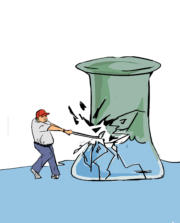
Lillian Huang
On April 2, President Donald Trump announced sweeping tariffs on nearly all of the U.S.’s trading partners. Self-dubbed as “Liberation Day” for American manufacturing and industries, the policy included a 10% baseline tax on all imports and country-specific reciprocal tariffs. One week later, he announced a 90-day suspension on tariffs beyond the 10% baseline for countries who did not retaliate. Notably, China was exempt from this pause, with Trump increasing duties to 125% in response to their retaliation.
According to the White House, President Trump has declared the trade deficit a national emergency. This approach allows him to utilize laws such as the International Emergency Economic Powers Act to enact tariffs without congressional approval. Critics argue this is an abuse of power, as the IEEPA’s use in this context bypasses the legislative branch’s authority over trade policy.
“[Trump] found out later in his first term how much power the President has to implement, change [and] manipulate tariffs,” said U.S. Government and Economics teacher Carlo Corti. “[Now] he’s using … it for both political and economic reasons, and that can be confusing to people who want to know … how much things are going to cost.”

TRUMP’S GOAL
At their core, tariffs are taxes imposed by a government on imported goods, which tend to reduce entry into a market by foreign companies.
“Tariffs alone are a useful tool,” said Lilly Loghmani, Aragon alumni and Barnard Economics student. “They can protect certain industries and help them develop inside the U.S., or they can protect the U.S. from unfair trade practices, like if a certain country engages in monopolistic behavior, dumping lower prices, etc.”
This perspective aligns with broader goals cited by the Trump administration, such as revitalizing domestic employment.
“Trump mentioned the idea of wanting to bring American jobs back to America that have been lost to globalization trends over the last 50, 60 plus years,” said U.S. Government and Economics teacher Heather Sadlon. “And also there’s a pretty big trade imbalance, so he’s looking at trying to put the U.S. more on the positive side of trade with this [current] kind of globalization.”
Politically, however, tariffs can be used as leverage in international negotiations or as a show of strength, making them a bargaining chip.
“He’ll say sometimes it’s for helping our industries out, but he will also say, ‘I’m putting a tariff on Canada because they’re letting fentanyl into this country’ or ‘because they’re letting illegal immigrants in this country,’” Corti said. “That is a very clear punishment for something another country does politically.”
EFFECTS OF TARIFFS
The reality of these tariffs becomes more complicated when considering their ripple effects on consumers.
“Every industry somewhere in their supply chain are getting some sort of goods and services internationally,” Loghmani said. “They’re going to face higher costs, and those are eventually going to get placed on the consumers … Placing tariffs like this go against free trade principles [and] a free market, which is what’s touted as the ideal economic structure by a lot of people … So in a sense, this is basically sabotaging a lot of the U.S. industry.”
Additionally, by isolating the United States from the global market, Trump undercuts the benefits of comparative advantage, in which countries focus on producing what they’re best at and trade for the rest.
“There’s a reason why we use China, Vietnam and the Philippines for labor, because it’s cheap, and we benefit from that,” said senior Adin Beltran. “We buy our clothes for cheaper, and we can specialize in [making] tech … That’s the point of [specialization]: everything will come at a cheaper cost because some other country will produce it for cheaper, so you can just import it and then specialize in something else.”
Of course, the real-world impact of tariffs extends beyond just economic theory; it affects everyday people and businesses.
“My mom’s [company has] to outsource work to other countries, and [because] Trump wants to tariff almost everything that comes into the U.S., [it] just makes it harder for companies to make a profit,” Beltran said. “My mom’s job is in danger because of increasing costs to operate, so they need to fire people to make room for that.”

RECIPROCAL TARIFFS
Traditionally, reciprocal tariffs are defined as equal tariff rates imposed in response to another country’s tariffs. By contrast, Trump’s retaliatory tariffs were calculated based on the ratio of the U.S. trade deficit with a country to the total value of imports from that country, which could be seen as a measure of the imbalance in a trade relationship. In relationships with economically disadvantaged nations, which may not be able to afford large volumes of American imports but rely heavily on exports, high tariffs reflect a natural imbalance between wealthy and poorer nations, not trade barriers. Moreover, the administration’s inclusion of factors such as currency manipulation and other non-tariff barriers in the tariff calculations were not consistently applied or defined, leading economists from the American Enterprise Institute to suggest that some tariffs were overinflated by a factor of four.
“The U.S. has essentially cut off all of its allies for whatever reason, and Europe has already started making plans without the U.S. being a major player,” said senior Gio Rodriguez. “China, Japan and South Korea, countries which all historically have almost 3,000 years of beef, basically, have come together … just in response to what Trump is doing currently, which I just find hilarious on one hand, and so deeply worrying because how are you able to be this dividing and yet ironically uniting.”
As countries retaliate with their own tariffs, they could target key U.S. industries, disrupting global supply chains, with the potential to isolate the U.S. from its traditional allies. Such a trade war could leave the U.S. surrounded by adversarial nations, creating economic and political tension long-term.
EFFECTS ON STOCK MARKET
The U.S. stock market has also experienced significant volatility following the President’s announcement of tariffs. On April 3, the S&P 500 companies lost a combined $2.4 trillion in value, the largest one-day loss since COVID-19’s start, followed immediately afterward with a more than 9% climb after Trump’s suspension announcement.
“Stocks aren’t a measure strictly of welfare or economic strength; they’re a measure of expected returns from investments,” Loghmani said. “But the fact that we are seeing … such a huge dip in the stock market means that even investors have major concerns over investor policies … Every industry, index funds, etc, are all expecting to brace for impact.”
This sharp market reaction emphasizes growing economic uncertainty.
“‘[People aren’t] going to invest in a company if [they] don’t know what the effects of tariffs on that company would be,” Corti said.
Tariffs are often framed as a way to protect American industries and workers, yet the costs they generate can ripple down to consumers.
“The public can’t have it both ways,” Beltran said. “Many Americans see protectionary acts like tariffs as a good for the U.S. economy, because we hear like, ‘protect American jobs’ or things like that, and we get pretty patriotic about it, but we also hate it when prices of goods go up, and a company that has to pay more for imported goods are going to raise the prices on consumers.”
As global markets react to the growing tension between the U.S. and its allies, the effectiveness of these tariffs remain uncertain.



